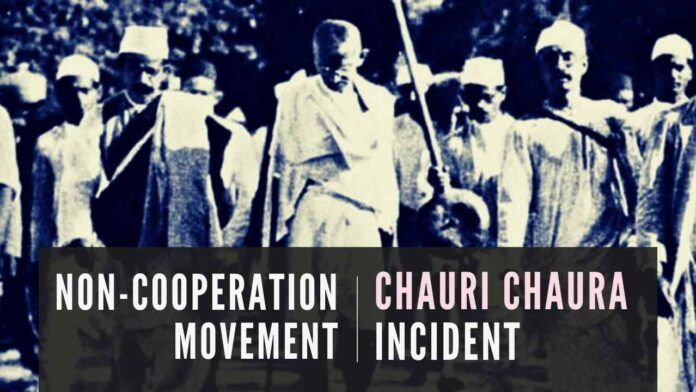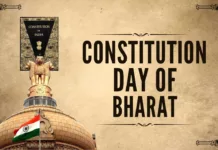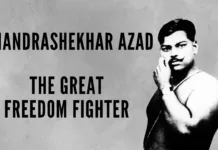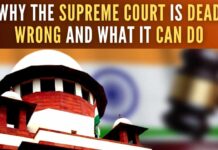
Why was the Rowlatt Act, 1919 opposed?
It has been a century since Mahatma Gandhi rose into prominence in the Indian Political movement for freedom. It was his opposition of the Rowlatt Act – 1919, by using Satyagraha and the promise of winning Swaraj within six months if Hindu-Muslim unity is achieved and some other conditions were fulfilled. Gandhiji always said that there is no Swaraj without Hindu-Muslim unity.
The infamous ‘Butcher of Amritsar’ Brigadier-General Reginald Dyer, in a murderous rage, killed thousands of peaceful Indians protesting against the Rowlatt Act at Jalliawala Bagh on April 13, 1919. He had told his son before he rushed to Amritsar to militarily control the civil disobedience movement of Satyagraha, “Mussulman and Hindus have united. I have been expecting this, there is a big show coming.”[1]
Jallianwala Bagh massacre resulted in violence in Punjab, Gujarat, and Bengal that deeply hurt Gandhiji who called off the campaign of Satyagraha against the Rowlatt Act on April 18, 1919. However, Gandhiji’s appeal for Satyagraha and Hartals had began to unite and connect the Indian masses towards the freedom movement and made him a very popular leader of the mass populace across India.
Under the guidance of Gandhiji, Indian National Congress held joint conferences with leaders of Khilafat and accepted the Khilafat Committee’s call of non-cooperation against the British[1]. Dr. B R Ambedkar in his Book, Pakistan or the Partition of India wrote that “Swaraj was not its primary object, It was Khilafat and that Swaraj was added as a secondary object, to induce the Hindus to join[1].”
In 1919, the supporters of ‘Khilafat’ or ‘Caliphate’ or the ‘Islamic State’ movement went to the length of inviting the Amir of Afghanistan to invade India.[2]
On September 05, 1920, a non-cooperation movement against the British Raj with the demand of full independence and self-governance was launched by Gandhiji. He was able to successfully unite Hindu and Muslim communities in civil disobedience against the British by supporting the Khilafat movement of Indian Muslims.
On the other hand, the objective of the Islamic Movement of the ‘Caliphate’ was two-fold: to preserve the ‘Caliphate’/ Khilafat and to maintain the integrity of the Turkish Empire. During those years, the word ‘Islamic extremism’ was yet to be mainstreamed, it still existed, though.
The Brotherhood between Khilafat ‘Caliphate and Non-Cooperation & the Cost of ‘Coming Together with Extremists’.
Gandhiji visited Calicut, Malabar on 18th August 1920 to gather support for non-cooperation and shore up the Khilafat base through meetings and fundraising.
A secret abstract of the Bombay Presidency police mentions Gandhiji’s meeting in Calicut as, “There was little sympathy with the non-cooperation movement at Calicut barring for a few fanatical Mappilla youths[3].” Gandhiji has said in his speech at Calicut, “If the Mussalmans of India offer non-cooperation to the government in order to secure justice on the Khilafat, it is the duty of every Hindu to co-operate with their Moslem brethren.”[3]
A 12-year-old young Sikh boy, namely ‘Sardar Bhagat Singh’ who was witness to the British’s macabre acts of Jallianwala Bagh massacre and the martial law atrocities, saw a messiah in Gandhiji and joined the non-cooperation movement.[4]
However, the Mopla youths whom Gandhiji visited in August 1920 had some other plans. They responded to the clarion call for non-cooperation; as their leaders Variyankunnath Kuhuharned Haji and Karat Moideen Kutty Haji, spearheaded the Malabar Hindu genocide of 1921 that led to the mass execution of thousands of Hindus, forcible conversions, rapes of Hindu women and children, and destruction of Hindu properties and places of worship.
In his Article in Young India on 20th October 1921, Gandhiji said, “I claim that with us both the Khilafat is the central fact, with Maulana Mahomed Ali because it is his religion, with me because, in laying down my life for the Khilafat, I ensure safely of the cow, that is my religion, from the Musalman knife.”[5]
The Six-month long genocide came to an end in January 1922 as the British captured the last of the Mopla terrorists. The Congress working committee downplayed murders, dacoities, forced conversions, and outrages on Hindu women by labeling Mopla’s extremist ideology as ‘instances of so-called forcible conversion by some fanatics among Moplas.”[2]
Mrs. Anni Besent, Theosophist, and founder of Home Rule League wrote in her book, ‘The Future of Indian Politics’ (Theosophical Publishing House, 1922, pg. 252): “The fourfold programme was begun formally on August 1, 1920; Swaraj was to be attained in a year, and on August 01, 1921, the first step was taken in the Malabar Rebellion; the Musalmans (Moplas) of that district after three weeks of preparing weapons, rose over a definite area in revolt, believing, as they had been told, that British Rule had ceased, and they were free.”
“The Musalmans (Moplas) of that district after three weeks of preparing weapons rose over a definite area in revolt. They established the Khilafat Raj, crowned a King, murdered and plundered abundantly, and killed or drove away all Hindus who would not apostatize. Somewhere about a lakh (100,000) of people were driven from their homes with nothing but the clothes they had on, stripped of everything,” she added further.
Annie Besant’s scathing remarks about the Islamic character of Mopla outrage are worth an evoke: “Malabar has taught us what Islamic rule still means, and we do not want to see another specimen of the Khilafat Raj in India. How sympathy with the Moplas is felt by the Muslims outside Malabar has been proved by the defence raised by them for.”
She further added that “Malabar has taught us what Islamic rule still means, and we do not want to see another specimen of the Khilafat Raj in India.”[6]
The severity of the Mopla genocide was spine-chilling still, Gandhiji did not call off the non-cooperation movement nor did he withdraw support to the Khilafat.
Instead in his appeal to the liberals on November 07, 1920. Gandhiji said, “Forcible conversions are terrible but Moplah bravery must command admiration. These Malabari’s are not fighting for the love of it. They are fighting for what they consider as religion and in a manner, they consider themselves religious.”[7]
Chauri Chaura Incident: Feb 04,1922
It was February 1922, roused by Gandhiji and the Khilafat movement; countless volunteers had joined in Chauri Chaura protests, as the non-cooperation movement had reached its pinnacle.
On February 04, 1922, police fired on a large group of Chauri Chaura protesters killing three and injuring several others. The mob got furious and burnt down the police station, with 23 policemen trapped inside. Gandhiji withdrew the non-cooperation movement in the wake of the Chauri Chaura incident on February 12, 1922.
Even the Chauri Chaura incident had an extremist angle as according to one version as given in the book ‘Event, Metaphor, Memory: Chauri Chaura’, by Shahid Amin, “The real agents (Asli log) involved in the riot are, again, other people altogether in the narrative from Madanpur, a Pathan-trader dominated market village twenty miles south-east of Chauri Chaura.”[8]
Like the young teenage Sardar Bhagat Singh, thousands of youth across India suddenly felt disillusioned from Satyagraha and other Gandhian philosophies due to his abrupt cancellation of the non-cooperation movement.[9]
And, I quote Dr. B R Ambedkar, “Mr. Gandhi was anxious to preserve Hindu-Moslem unity and did not mind the murders of a few Hindus if it could be achieved by sacrificing their lives. This attitude to excuse the Muslims any wrong, lest it should injure the cause of unity, is well illustrated by what Mr. Gandhi had to say in the matter of the Mopla riots.”[2]
Mrs. Annie Besant and Dr. Ambedkar’s apprehensions about the Khilafat being the extremist version of Islam were not misplaced. As we stand in the twenty-first century, a hundred years after the ‘Caliphate’ and non-cooperation movement, we are able to witness some of the most catastrophic events of the previous century through the hourglass, which has proven beyond doubt that corroboration with Islamic extremists has time and again proven to be detrimental.
Gandhiji is long gone, his ideology has been revered the world over but in his motherland, his Satyagraha and Khadi have turned into political symbols as Khadi has lost its relevance.
On the other hand, the extremist ideology of the Islamic State ‘Caliphate’ is here to stay. A cleric wants to turn Kerala into an Islamic State within the next 10 years[10]. The Islamic State had found one of its initial Indian recruits from Kerala.[11] A recent UN report has stated that there are “significant numbers of ISIL operatives in Kerala and Karnataka states.”[12]
The Malabar massacre will remain a black day in Indian history. There can be no end to Islamic extremism as long we keep mum and remain politically correct. The only way to end extremism is to fight against it. One has to be really honest and call spade a spade. This is not just extremism, it is radical Islamic terrorism.
Note:
1. Text in Blue points to additional data on the topic.
2. The views expressed here are those of the author and do not necessarily represent or reflect the views of PGurus.
Reference:
[1] Amritsar 1919 – An Empire of Fear and the Making of a Massacre – Feb 01, 2019, Amazon.in
[2] Pakistan or the Partition of India – Amazon.in
[3] Bombay Presidency Police Secret Abstract of Intelligence, Vols, from 1920 to 1943 (Home Department, Government of Bombay, 1920 to 1943) – Cultural Maha Govt
[4] Symbol of courage & patriotism – Mar 18, 2007, The Tribune
[5] GANDHI’S APPROACH TO HINDU-MUSLIM PROBLEM AND PAN-ISLAMiSM (1890-1930) – Core UK
[6] The Future of Indian Politics (Theosophical Publishing House,1922, pg. 304) – Archive
[7] Page:Speeches And Writings MKGandhi.djvu/730 – Wiki Source
[8] Event, Metaphor, Memory: Chauri Chaura, 1922-1992, Shahid Amin, (Oxford University Press, 1995, pg.34, 132) – Weebly
[9] IDEOLOGY OF MAHATMA GANDHI & BHAGAT SINGH – Shodh Ganga
[10] ‘Will turn Kerala into Islamic Caliphate within 10 years’; preacher Mujahid Balussery comes up with controversial statement – Sep 12, 2020, Kerala Kaumudi
[11] Kerala Man, Trained By ISIS In Iraq, Guilty Of “Waging War Against India” – Sep 25, 2020, NDTV
[12] ‘Significant numbers’ of ISIS terrorists in Kerala, Karnataka: UN report on terrorism – Jul 26, 2020, ET
PGurus is now on Telegram. Click here to join our channel and stay updated with all the latest news and views
For all the latest updates, download PGurus App.
- Beware the ides of February; three years since Balakot: Now What? - February 13, 2022
- Chauri Chaura – A century of non-cooperation movement and the ‘Caliphate’ movement - February 11, 2022










